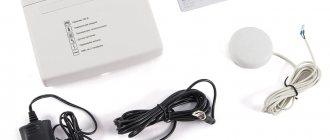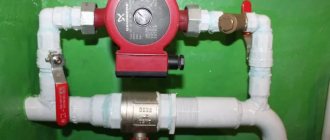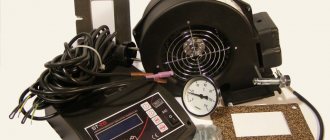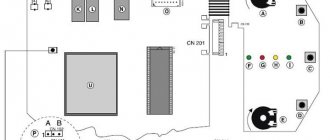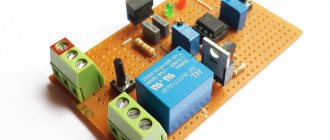The use of automatic control makes the devices operate more efficiently. Solid fuel boilers thus better use the energy from fuel combustion, reduce the requirements for quality and intensity of maintenance, and become more autonomous. Having understood the basic principles of operation of control devices, the owner will be able to correctly select the necessary equipment and ensure its effective use.
Solid fuel boiler in the house Source tproekt.com
Why is it worth equipping your heating boiler with a remote control system?
The need to equip a home with a system that can remotely control a heating boiler becomes obvious not only if permanent presence is not possible, but in terms of direct economic benefits and general convenience from such an event:
- Opportunity to save up to 45-50% of money spent on heating your home every month;
- Increasing the service life of heating equipment due to fewer switches on and off of electronics;
- For any prolonged absence, you can reduce the room temperature and increase it in advance of your arrival;
- During thaws, the GSM control system for the gas boiler will turn it off automatically;
- You can set heating modes for night and day;
- Ability to maintain different temperature levels in different zones (rooms);
- All information about non-standard situations will be immediately transmitted by the gas boiler control unit for prompt decision-making;
- The heating system can be turned on automatically before the onset of cold weather.
How to solve the issue from the technical side
Regardless of which heat supply system is responsible for heating the room (except, of course, manually loaded wood stoves and fireplaces), it can be equipped with electronics for remote control of the heating boiler.
Setting the heating mode when controlling the boiler remotely
This is due to the fact that most modern boiler systems have electronic matching boards in their structure, through which remote units can be connected. If the equipment for heating old models does not provide for such modernization (or it is homemade), we will still resolve the issue.
The consumer has three main options to choose from on how to implement remote control of the boiler in their home:
- Using special GSM modules for controlling heating devices;
- By connecting the so-called “smart thermostat” via WI-FI;
- Equipping radiators with multifunctional thermostats.
Benefits of remote control
Not all home appliance users are supporters of new technologies. Many are quite satisfied with the usual mechanical control - simple, accessible, without unnecessary bells and whistles.
But before making final conclusions, we suggest considering the advantages of “smart” equipment, which not only makes life easier and more comfortable, but also allows you to significantly reduce costs.
By controlling a gas boiler from a distance, you can save from 20 to 50% of your total home heating costs by simply changing the operating mode or choosing the appropriate program
The main advantage of remote control of a gas boiler is hidden in the method itself: you do not need to be constantly present in the house, “communication” with the equipment occurs at any distance.
Moreover, it is two-way - you send commands to the unit, which it executes and, in turn, notifies you about the current parameters and instantly signals about failures and irregularities in operation.
The programming capabilities of heating equipment are limited, but still quite wide. Today, having a gas boiler with remote control, you can schedule the heating mode while at work, visiting or even on a long trip
Users who have successfully tested the remote control system highlight the following advantages:
- Increasing the service life of the boiler due to the optimal choice of mode, reducing the number of switching off/on, and, in general, more careful use.
- A long-term absence no longer threatens to return to a cold cottage - on the way home you can set the desired temperature.
- If external weather sensors are installed, you won’t even have to interfere with the operation of the boiler during a thaw or frost - the temperature will be adjusted automatically.
- From a distance, you can select a more comfortable “night” mode for sleeping.
- If an emergency occurs or any part fails, you will know about it right away.
Of course, a lot depends on the nuances of installation and the complexity of the heating system.
The advantage is that from a smartphone you can control not only the simplest, but also an extensive network - with radiator or convector heating, or a “warm floor” system.
On the open market you can find equipment for climate zoning, which will allow you to adjust a comfortable temperature in the rooms: in the bedroom or kitchen - lower, in the living room or children's room - higher
Some functions of the system start automatically, that is, you don’t even need to select a mode on your phone - the equipment will switch itself based on sensor signals.
Features and Properties
GSM heating boiler control has the following capabilities:
- ensure the required temperature regime in the house at any time of the year, and there is no need to be close to the boiler to change the temperature;
- from a distance, prepare the house for the arrival of the owners, setting a comfortable temperature there (even if the building has been empty for several weeks, its owners and guests will not have to return to the cold room);
- in winter, prevent freezing of pipes and their subsequent depressurization during unexpected frosts - you can increase the temperature in the boiler while away from home by simply sending a message;
Boiler control via GSM - the possibility of optimal fuel consumption - provide remote monitoring of the serviceability of the installed heating system - messages are sent in case of failures;
- heating operation in the shortest possible time in case of emergencies;
- ensure maximum fuel economy;
- increase the operating time of a gas boiler - due to timely response to emergency situations.
That is, GSM heating control by phone or via the Internet provides a previously inaccessible level of comfort in a country house or in a private home. This device is useful for those whose work involves frequent absences, who are often away, and have no one to constantly monitor the heating condition.
Types of remote heating control systems
In addition to the presented remote boiler control systems - using the Internet and using cellular communications, there is a third type, which is called combined. In this case, remote control of the heating boiler can be carried out in any convenient way, either using the Internet or using a mobile phone.
The following operating modes are provided for this system:
- Automatic - here the gsm controller for the heating boiler executes a number of specific programs, processing information received from external sources.
- SMS - operates by transmitting the parameters of the temperature sensor to the phone in the form of SMS messages, in this case the controller for the boiler configures the heating system using the input data.
- Warning – sends alarming SMS when critical situations arise.
- Provider - carries out remote coordination of related devices, such as heating elements for heating water, a thermostat for electric heaters, an electric boiler control unit or a gas boiler control board.
The equipment for the presented remote monitoring system has the highest cost. However, in this case, remote control can be carried out in any convenient way and from any location.
Atos
- Manufacturer: Poland;
- Power supply: 220V/50Hz;
- Connected pump power: up to 130W;
- Fan power: up to 130 W;
- Coolant temperature setting range: 35-80°C;
- Temperature measurement accuracy: 1°C
- Room temperature setting range: 25-50°C;
- Alarm when the set temperature range is exceeded;
- Relay output for additional alarm;
- Manual target temperature setting and circulation pump control.
- Estimated cost: 6750 rub.
Automation originally from Poland has proven itself well in combination with heating boilers of various types and designs with a capacity of 25-50 kW. Among the advantages is the possibility of igniting fuel in any weather conditions, increasing the efficiency of the boiler while maintaining a stable coolant temperature, according to the set value.
The control unit is compact, with a simple interface and a two-digit dial for setting all key parameters.
Options for controlling the boiler via smartphone
Three solutions are available for remote control of a domestic gas boiler:
- GSM module connection;
- use of a “smart thermostat” via WI-FI communication;
- installation of thermostats.
Each remote control method is good in its own way, and its choice depends on several factors: availability of the Internet, gas boiler model, financial capabilities.
Let's consider all three options - one of them may suit you, and as a result of a partial upgrade, managing the heating system will become much easier.
We recommend: Which is the best gas heater to choose for your dacha?
Option #1 – connecting the GSM module
This is the most common solution, applicable even in areas not covered by the Internet.
The gas boiler is controlled using a GSM unit - a compact controller module. A SIM card is inserted into it, which personalizes the owner and makes it possible to keep in touch with remote equipment
In order to save money, the homeowner can choose the most suitable cellular operator and favorable tariff.
The GSM module is programmable and its operating principle resembles a computer with limited functions. This block is connected to sensors installed both in equipment and in the environment - in rooms, on the street. Depending on the parameters produced by the sensors, the gas unit automatically changes the program or is controlled from a smartphone.
To communicate with the control unit installed in the house, you will need any electronic device - a laptop, tablet, but it is most convenient to use a smartphone, which is more compact and versatile
For ease of control, selection of modes and programs, developers have created applications for various operating systems: iOS, Android, Windows Phone.
There are several modes by which a gas boiler is controlled:
- Fully automatic control. The unit operates according to the specified parameters entered into the program in advance. If changes are required, the program should be adjusted.
- Transmission of alarm notifications in the event of emergency or repair situations. If there is a gas leak or the boiler suddenly stops working, a signal is sent to the smartphone.
- “Communication” using SMS messages. There is a list of commands that the automatic gas boiler recognizes and then makes changes to the operation of the equipment.
- Advanced management options. Using a special program, you can control all systems connected to the GSM unit.
The advantage of remote control via mobile communication is considered to be almost constant control and unlimited possibilities, depending only on the selected application and installed equipment.
A few more advantages of using a GSM module:
Image gallery Photo from Depending on the modification of the unit, you can connect several mobile phones to the module, and then from 2 to 10 people will be able to monitor the operation of the unit. In addition to the gas boiler, sensors installed in various rooms heated by the boiler can be connected to the module: in the kitchen, in the hall, bedrooms and even in the basement or attic In addition to the controller, key reader, antenna, sensors and power supply, you can connect a microphone, gate control unit and other “smart” devices By installing temperature sensors outside, you can set automatic mode changes depending on weather conditions Monitoring the operation of the boiler by all family membersConnecting additional sensors to the program Possibility of connecting basic or extended configurationsAutomatic operation of “weather” sensors
Problems can happen if the cellular connection is poor. The homeowner needs to carefully monitor the expenditure of funds - if the balance is negative, the ability to control the heating equipment will be interrupted.
Option #2 - using the Internet
If the Internet network extends to the area with your country home, then you can control the gas boiler using it.
A WI-FI router is installed in the house, and an Internet thermostat is connected to the boiler equipment. He is the link between the owner of the building and the heating equipment
As soon as the temperature in the room drops below normal, the sensor transmits a signal to the receiver, which interacts with the boiler and turns on the desired heating mode.
The user can control the entire process from a smartphone, monitor changes, and make adjustments. The provider acts as an intermediary between the home owner and the equipment. For continuous communication, it is important to provide access to the Internet both in the home and at the user’s location.
The advantage of the system is the unlimited number of gas boiler sensors - the heating level can be adjusted in all areas served by the building’s heating system.
As with remote control of a gas boiler via a GSM module, the homeowner can control the heating process remotely and make relevant changes. It is possible to install a program that changes the boiler operating mode depending on the time of day, days of the week, and season.
Thermostats, the operation of which depends only on the stability of the Internet connection, are different, but their operating principles are similar.
Portable temperature sensors with preset settings are installed in living rooms and other heated rooms. They are connected to an electronic thermometer, the program of which includes operating parameters
If desired, you can set an economical temperature regime for water used for domestic use or for heating “warm floors”.
The operation of the boiler and other equipment can be monitored using application diagrams or graphs. If an unusual situation occurs, the user receives alerts.
The boiler is controlled from an electronic device - a personal computer, tablet, smartphone, but there is also the possibility of manual control from a panel on the unit.
Option #3 – installing thermostats
If a router is installed in the house and the Internet is connected, it is possible to control even an old boiler model without electronic components and automation.
To do this, you need to buy universal type thermostats and create a network connecting all heating equipment. The system can be controlled via an Internet connection
The main element of the system is an electronic controller and a WI-FI transmitter “all in one”. It is programmed, after which it becomes possible to control heating functions in different zones. The number of such zones depends only on the capabilities of the homeowner - electronic thermostats can be installed on each radiator.
The controller is connected via a special channel to the boiler shutdown unit. If the need arises, the unit is turned off from a distance of hundreds of kilometers or from the next room. The controller is controlled not only wirelessly, but also manually, directly on the unit.
The thermostat system easily covers several zones, and up to 6 thermostats can be installed in each area.
Operating principle of the control unit (controller) for boilers
Controllers are electronic devices that are designed to optimize the control of a gas heating device under changing environmental conditions. The capabilities and functions of different devices differ, but they are united by the presence of pressure and temperature sensors.
Example of controller connection diagram
The electronic gas boiler control unit (ECU) is responsible for the operation of the gas burner, heating of the coolant and the safety of the system as a whole. Its operating principle is based on the use of an electromagnetic valve.
The controllers of the latest heating devices are equipped with an automatic mode function, which allows you to regulate the operation of the device during the week without human intervention.
Connecting the computer to external temperature sensors and boiler control terminals allows you to configure independent changes in the operation of the burner.
For such a controller, it is necessary to install a voltage stabilizer and an uninterruptible power supply to ensure the operation of the boiler during voltage surges in the network or in its absence.
Video description
About the automation that regulates the air supply to solid fuel boilers
Automation for a solid fuel boiler allows you to provide optimal combustion parameters for the fuel. This is achieved by controlling devices such as a circulation pump, fan and some others. Combustion data is collected using special sensors and transmitted to an electronic controller. After processing the received information, he makes appropriate changes to the operating mode of the solid fuel boiler.
Blower fan for boiler Source tproekt.com
Combustion occurs over a long period of time. At the same time, the fuel gradually burns out and the operating mode changes. If no action is taken, the efficiency of the boiler will decrease. To do this manually, the master needs appropriate knowledge and experience. The automatic system makes the necessary adjustments with minimal human intervention. This improves not only the efficiency, but also the safety of its operation.
Adjustable ash door Source tproekt.com
How to choose the right model
The main criterion is the specification of the model. There are devices that are suitable only for certain models of boilers from one manufacturer; they are produced as additional equipment for the boiler; information about their purpose is usually contained in the name itself. Of course, if this is possible, it is better to choose a GSM module from the same manufacturer as the boiler (it will be tailored to a specific line of models and their specifics).
We recommend: Izoplat: properties, characteristics, advantages and disadvantages, installation features
But there are also universal models that are suitable for absolutely any boiler that has the appropriate terminals; it is these universal GSM modules that are discussed in the article.
Today, the choice of universal GSM modules is small (about 20-25 models), so it is difficult to identify a sufficient number of criteria. We recommend studying the most famous and successful models (see below) and choosing from them, studying the functionality and convenience of each, comparing prices. But we also recommend paying attention to criteria such as:
- The presence of an application and web interface that significantly simplifies management and allows you to see and analyze work statistics. If the manufacturer has not provided interface examples, it is worth looking for screenshots in the image search of any search engine.
An example of the web interface of ZONT modules, the interface is available in your personal account on the manufacturer’s website. - Standard equipment. Some modules are supplied with external temperature sensors, which can be placed in rooms remote from the boiler room and be guided by their measurements, which is an obvious advantage. A good option is the one with an external antenna, which allows you to seriously improve the quality of communication, and in some cases, when you move the antenna higher, you can even catch a signal that is missing on the ground floor or in the basement of a remote house.
- The capacity of the built-in battery should be at least 100-150 mAh, with these parameters it will be enough for 2-4 hours of operation of the module.
DIY heating connection diagrams for a private house
In the case of installing a parapet gas boiler, which can also be double-circuit, you will need to separately install a circulation pump placed on the return pipe, as well as an expansion tank and other additional piping. Even today there are supporters of this method of wiring communications for heating a room.
Heating devices
In the absence of special instructions, the following rules are used when installing the boiler: The width of the passage on the front side of the boiler must be at least 1 m. In small private houses, the following types of two-pipe heating systems are used: dead-end; collector beam. The main disadvantage of such wiring is a slight increase in pipe footage. In this case, the hot water coming from the boiler flows to the radiators through one pipe, and the already cooled coolant is removed through another. They are considered one of the most durable and economical boilers.
Fluctuations are recorded by sensors, and if necessary, the system brings them to normal parameters. This pump belongs to the category of emergency equipment and runs on a battery. The main task of the pump is to supply cooled water to the boiler to heat it and distribute the already heated coolant throughout the system. In addition, the use of such a heating scheme with an electric boiler implies a complex balancing process. The equipment must include a box with C16 circuit breakers, which are installed at home next to the unit.
A prerequisite for proper circulation of water in a gravity system is the installation of pipes at a slight angle. Even when using a multi-tariff system, the cost of heating a house in this way will be an order of magnitude higher than in the case of a wood heater. All solid fuel boilers are based on the Kolpakov principle, when the boiler is first heated, and then the temperature is maintained at a certain level to ensure stability of heating of the coolant. To achieve a good effect in using the generated energy, it is necessary to install a heat accumulator. After all, the batteries will go along the internal perimeter, along the load-bearing walls, and even the last radiator should be located slightly above the boiler. Connecting a heated floor to the heating system. 4 connection methods.
Remote control of the boiler using multifunctional thermostats
When the house has an outdated heat supply system without any hint of the ability to connect electronic units, there are no three-way valves and other automatic equipment - you can buy universal thermostats on the market that can easily be combined into a branched system into many zones with the ability to control heating via the Internet.
The kit of such equipment includes an electronic controller, where all settings for each zone take place.
It doubles as a WI-FI transmitter-receiver and through this channel “communicates” with electronic thermostats installed on each battery.
Remote control of the boiler using a Vaillant programmer
It has a separate channel connection with the boiler shutdown unit. Heating parameters can be changed either on the controller itself manually or via the Internet.
Some remote heating control systems of this type allow you to control up to 8 zones, each with 6 thermostats.
Air
- Manufacturer: Ukraine;
- Power supply: 220V/50Hz;
- Connected pump power: up to 450W;
- Fan power: up to 220 W;
- Coolant temperature setting range: 40-85oC;
- Temperature measurement accuracy: 0.1°C
- Room temperature setting range: 20-45oC;
- Estimated cost: 3000-3500 rubles.
Compact automatic control unit for solid fuel boilers. Allows installation and control of a powerful circulation pump and fan with a corresponding load current of 2 and 1 ampere; the modification allows load currents of up to 5A.
The most common breakdowns in the control unit
Since the control unit is a whole system, a failure can occur from any deviation of a component of this system. The most common malfunctions and their causes :
- the burner went out - air got into the gas pipeline;
- heating problems - poor gas supply, lack of oxygen;
- boiler overheating - closed contacts, prolonged operation at high temperatures, factory defective sensors;
- breakdown of the pneumatic relay (draft sensor) - incorrect connection, fan breakdown, incorrect smoke exhaust system;
- breakdown of the temperature sensor - incorrect connection of contacts, short circuit, overheating of the board;
- breakdown of the pressure switch - low water pressure in the pipes, defective contacts in the circuit board.
Most of these problems are easily fixed, even described in the instructions, but some require the intervention of a specialist.
You should not replace sensors or other parts yourself - this can be dangerous.
Expert advice: how to protect yourself from controller breakdowns
Repair of control units for gas boilers is not a common occurrence. However, before purchasing equipment from a certain manufacturer, ask if there are service centers in your region.
To protect yourself from troubles at the wrong time, you should, with the help of specialists, inspect the boiler before and after the heating season. A network voltage stabilizer will help protect the electrical controller from pressure surges, thereby protecting the device from damage.
You can prevent possible damage to the control unit the first time it is put into operation. The unit system is complex and fragile in its own way; settings may be lost during transportation or assembly of the equipment. Therefore, during installation, they first carefully check all the subtleties associated with the wiring, water and gas supply, and then check the operation of the CU sensors.
The latest models of controllers have been brought to almost complete independence. The gas boiler control unit reports faults using indicators, as can be seen in the diagram below.
If you notice any failure, even a minor one, it is better to immediately call a boiler service specialist, this will prevent a serious breakdown and save yourself from more serious problems.
Heating appliances are often the subject of experiments, which result in towel dryers for example. At a technology competition in 2007 in the United States, among the various designs one could see a radiator in the form of a rack of hangers, designed in the shape of a chair with a heated seat.
Modern home heating equipment is as convenient as possible for users. Having set the necessary parameters for the device, you do not need to constantly monitor its operation, relying on the automatic mode. And timely diagnostics of heating devices will allow you to avoid troubles due to incorrect operation or breakdowns.
An example of installing the controller can be found in the video:
Installation recommendations
A simple automated unit for monitoring and controlling a heating system of the XITAL type can be installed with your own hands if you carefully understand the operating instructions. Mounting the device and installing the sensors is not particularly difficult, as is their connection. The included cables are long enough to carry the sensors throughout your home. But there are nuances that must be taken into account when organizing heating control.
The first is the presence of good GSM coverage at your place of residence. It happens that in one place there is coverage from several cellular operators, but none of them works reliably. In this case, KCITAL is equipped with two slots for SIM cards to duplicate messages. The second caveat is that before inserting the SIM card into the slot, you must contact the operator and disable the sending of any advertising content in the form of SMS. Such messages arriving at the device number may cause malfunctions in its operation.
Advice. It is better to purchase a new SIM card for the heating control unit with a “clean” history of use.
The same recommendations can be given regarding devices that interact with the owner via the Internet. The cable connected to the LAN input should not come from a router or modem powered by a 220 V network. Otherwise, if there is a power outage, the communication channel will also be lost. The devices themselves must always have their own battery, which can ensure their operation for at least 3 days. Detailed recommendations for installing XITAL can be obtained by watching the video:
Tech
- Manufacturer: Poland;
- Power supply: 220V/50Hz;
- Connected pump power: up to 200W;
- Fan power: up to 200 W;
- Coolant temperature setting range: 30-80°C;
- Temperature measurement accuracy: 1°C;
- Room temperature setting range: 20-45oC;
- Manual target temperature setting and circulation pump control.
- Estimated cost: 6500-7250 rubles.
Functional control unit with practical overheat-protected housing. User-friendly interface. The presence of an LCD display and an expanded set of control keys makes it easier to configure the automation and control the operation of the boiler.
Instructions for installing and connecting the GSM module to the boiler
Installation and connection to the boiler for all GSM modules is practically no different, and the detailed algorithm is always described in the device instructions. Let's look at the connection process using the example of "Boiler OK".
| Photo | Description of action |
| Press the corresponding clips on the sides of the case and open the back cover to access the SIM card slot. | |
| Insert the SIM card into the slot. There should be no restrictions or PIN codes on the card, a convenient tariff and a positive balance must be connected. | |
| Screw on the antenna. Insert the power adapter into the appropriate connector and plug the cord into the outlet; during normal operation, the power LED should light continuously (see photo). Turn the battery switch to the “on” position, the corresponding indicator should light up. After some time (about 10 seconds), the GSM indicator should light up, indicating that the device has registered in the network. To complete registration, call the number of the inserted SIM card. The registration process differs depending on the model, but is always described in the instructions. | |
| All that remains is to connect the module to the boiler. To do this, you need to find special contacts inside the boiler that are responsible for external control or an external temperature sensor (their location can always be found in the boiler instructions). As a rule, there is a jumper between these contacts that needs to be removed. All that remains is to connect the corresponding contacts in accordance with the instructions; this is done using any wire with a cross-section of 0.5 mm2, just insert the cable and tighten the terminals with a screwdriver. Such cables are not included in the kit due to the requirements for their length, which are always individual. |
Homemade electric heating boilers
Having the skills to work with metal, having the necessary material and tools, it is easiest to make homemade electric boilers - electrode or heating elements. If a heating element is used as an electricity converter, then you need to make or select a steel housing in which it will be installed. All other components - regulators, sensors, thermostat, pump and expansion tank are purchased separately in specialized stores. Electric boilers can be used in closed or open heating systems.
What is needed and how to make a 220V electric heating boiler with your own hands, efficient and reliable?
You need a steel container in which one or more heating elements are placed in accordance with the drawings or sketches for the product being created. Even at the stage of the project for do-it-yourself heating boilers, the drawings should provide for the possibility of quickly and easily replacing a burnt heating element. For example, the body can be made of a steel pipe with a diameter of 220 mm with a body length of about 0.5 m. Flanges with supply and return pipes and seats in which heating elements are installed are welded to the ends of the pipe. The circulation pump, expansion tank and pressure sensor are connected to the return line.
Features of power supply of electric boilers
Heating elements consume significant power, usually more than 3 kW. Therefore, for electric boilers you need to create a separate power supply line. For units with a power of up to 6 kW, a single-phase network is used, and for higher power values, a three-phase network is required. If you equip a homemade heating boiler with a heating element with a thermostat and connect it through RCD protection, then this is an ideal option. When installing conventional heating elements, the thermostat is purchased and installed separately.
Electrode heating boilers
Boilers of this type impress with their extreme simplicity. It is a container in which an electrode is installed; the second electrode is the boiler body. Two pipes are welded into the container - supply and return, through which the electrode boiler is connected to the heating system. The efficiency of electrode boilers is close, like that of other types of electric boilers, to 100% and its real value is 98%. The famous Scorpion electrode boiler is the subject of heated debate. Opinions are extremely varied, from excessive admiration to complete denial of use for heating circuits.
It is believed that electrode boilers were designed for heating submarines. Indeed, the manufacture of heating boilers requires a minimum of materials, sea water with dissolved salts is an excellent coolant, and the hull of the submarine, to which the heating system is connected, is an ideal grounding. At first glance, this is an excellent heating circuit, but can it be used for heating homes and how to make an electric heating boiler with your own hands, repeating the design of the Scorpio boiler?
Electrode boiler Scorpio
In electrode boilers, the coolant heats the current passing between the two electrodes of the boiler. If distilled water is poured into the system, the electrode boiler will not work. There is a special salt solution for sale for electrode boilers with a specific conductivity of about 150 ohm/cm. The design of the unit is so simple that making a Scorpio electric boiler with your own hands, if you have the necessary skills, is quite simple.
Two pipes are welded to this pipe for connection to the heating system. Inside the device there is an electrode isolated from the body. The boiler body plays the role of a second electrode; the neutral wire and protective grounding are connected to it.
Disadvantages of electrode boilers
The main disadvantage of electrode boilers is the need to use saline solutions, which adversely affect radiators and heating pipelines. The heating system may require a complete replacement of radiators, especially aluminum ones (more information about which you will read here), and piping within a few years. Circulation pumps that are designed to work with antifreeze or clean water are at great risk. The second huge drawback is that electrode boilers require ideal protective grounding of the housing, otherwise they pose a huge risk of electric shock. It is prohibited to sell and install such equipment in foreign countries!
The best known manufacturers and models: characteristics and prices
"Kotel OK"
The most popular on the market, one of the best and most inexpensive GSM modules for heating boilers made in Russia. In addition to the price, it is distinguished by its compact size, extremely simple and easy setup, and the presence of an application that can send commands, including in the form of SMS, which is an excellent option that allows you not to use tariffs with Internet access.
The functionality of the device is quite simple, the minimum required: temperature control, setting alerts, checking boiler operating parameters, and the module also has a built-in relay that allows you to turn the boiler on and off.
Among the disadvantages, it is worth noting a rather simple application with the minimum required functionality and an outdated interface, the presence of an external temperature sensor with a cable length of only 0.5 meters, which does not imply its installation in other rooms remote from the boiler room. The antenna is also not remote, screwed into the device via a threaded connection.
Cost: 3,990 rub.
XITAL GSM 4T
Another well-known, more professional and versatile device with a much richer package. The heating control functionality in it is approximately the same as in the previous “Boiler OK” - the minimum required, however, there are as many as 4 zones for additional devices (flow sensor, smoke sensor, motion sensor, flood sensor, door opening sensor, etc.). Also included is an electronic key and a reader (similar to those installed in intercoms), so you can influence the settings, if desired, only with an electronic key.
The main difference is the presence in the kit of two remote temperature sensors with a wire length of 10 m, as well as a remote wired antenna and a cord for connecting a backup external battery (unfortunately, there is no built-in one). Management and control can be carried out both via SMS and through the application.
The disadvantages, in addition to the lack of a built-in battery, are the ineffective and inconvenient, although understandable, application interface, less attractive appearance with exposed terminals and large dimensions. Please note that for heating you must choose a model that has a “T” at the end.
Cost: 8,640 rub.
EVAN GSM CLIMATE
Also known as ZONT H-1, it features a more modern and convenient application, with ready-made “Economy” and “Comfort” modes, as well as the ability to program boiler operating parameters. It is enough to configure the boiler operating pattern once and the module will automatically issue commands to the boiler to change parameters depending on the time or day of the week. Control via a web interface is also available. The standard package includes one remote temperature sensor and a remote antenna.
Perhaps the only drawbacks are the lack of a built-in battery and only one contact for connecting an external temperature sensor.
Cost: 6,780-8,840 rub.
ZONT H-1V
A more advanced analogue of the previous GSM CLIMATE (ZONT H-1). Despite its less attractive appearance, it has an additional “Anti-Freeze” mode and a built-in battery for autonomous operation during power outages. Number of connected temperature sensors – up to 10 pcs.
Otherwise, due to the same firmware, everything is similar to the previous model: the same control via SMS, application or web interface, which, by the way, is one of the most convenient and functional, with statistics. The kit still includes one remote temperature sensor and a remote wired antenna.
Cost: 7,400-9,200 rubles.
Reviews on the use of household automation kits: advantages and disadvantages
| Advantages | Flaws |
| Increased efficiency - achieved through precise adjustment of the blower, stable heat output throughout the entire combustion (in contrast to peak values during intense combustion and minimum values during the afterburning period with a standard boiler design) | Additional noise - the operation of the fan implies the presence of additional sounds, however, according to reviews from the owners, the noise is practically inaudible even through the thin walls of the boiler room. |
| Fuel economy - less fuel is required to achieve the same heating performance, a huge part of the excess heat does not “fly down the drain” | Additional costs - the cost of a standard “controller + fan” kit averages 7-11 thousand rubles. If desired, a room thermostat (about 1-3 thousand rubles), an automatic feeding system (from 10 thousand rubles) |
| Maintaining a constant temperature | Volatility - the boiler will require a connection to the electrical network to operate |
| Automatic ignition and extinguishing (optional) | |
| Possibility of external control - by connecting a room thermostat or outdoor sensors, the automation will focus not on the temperature of the coolant, but on the temperature in the room or outside, which is more efficient and comfortable | |
| Increasing the burning time of one bookmark, the ability to connect an automatic feeding system | |
| Safety - most controllers are equipped with protection against overheating or stopping the circulation pump |
